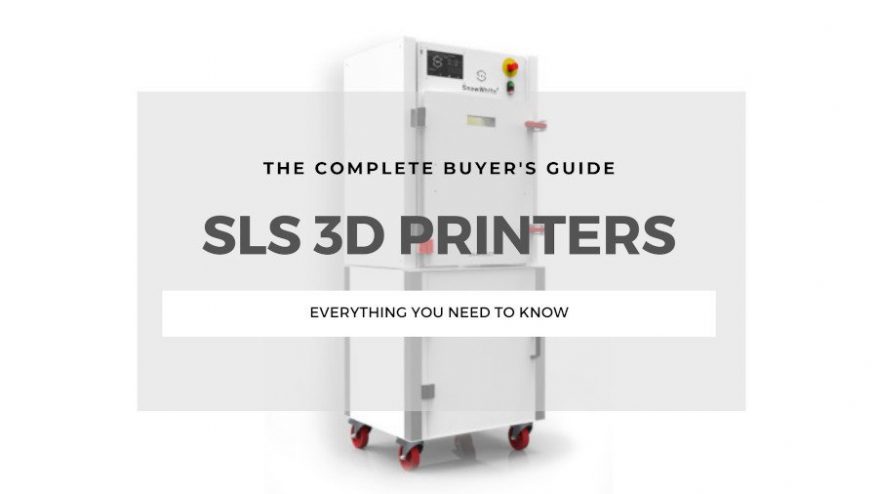
Selective Laser Sintering is one of the main plastic 3D printing technologies for creating accurate parts on demand. SLS 3D printers create accurate prototypes by sintering plastic powders using a laser. As with Fused Deposition Modeling, the part is traced layer-by-layer to gradually create the finished part.
Introduction: A Short History of SLS Printing
Closely following Stereolithography as one of the first 3D printing technologies invented, Selective Laser Sintering was theorized by Carl Deckard in 1988 who filed the patent while working at the University of Texas. Instead of using a UV light as with Stereolithography, SLS involves powder 3D printers using a laser to trace and solidify layers of powder polymers to create a finished part.
Until recently, SLS 3D printers were industrial 3D printers costing tens of thousands of dollars. However, with recent patents expiring and a renewed interest in 3D printing, several more affordable SLS 3D printers have been developed, starting at a few thousand dollars.
- You can also view our in-depth Selective Laser Sintering guide here.
SLS 3D printer materials
SLS printers have a more restricted material range than technologies like FDM, mostly restricted to Nylon Polyamide powders. Some are restricted to just black PA12, whereas some can also print powders including PA11 and PA6.
Increasingly, powder mixes are compatible with industrial and desktop SLS 3D printers. These include glass mixes, carbon fiber mixes, and even food-grade powders for niche applications. Increasing numbers of SLS printers can print TPU, a flexible rubbery material.
But what is the best SLS 3D printer on the market today?
Best Desktop / Cheap SLS 3D Printers under $15,000
Firstly, we have listed the desktop SLS 3D printers. These are defined as printers under $15,000 and are appropriate for small business rapid prototyping rather than solely industrial work.
Note: we have ordered these printers by price.
Sinterit Lisa
- SLS 3D printer price: €9,995 — Available on 3DPrima here
- Company based: Poland
- Print volume: 150 x 200 x 150 mm
Pros
Affordable SLS printer.
Precise.
Compatible with Nylon and Flexa black materials.
Cons
Not portable, weighing in at 41kg.
The Sinterit Lisa is an affordable SLS printer made by Polish manufacturer Sinterit. Compatible with the usual PA12 Nylon and Flexa black materials, the Sinterit Lisa offers a 150 x 200 x. 150 mm printing volume, enough for most single-part projects.
The Sinterit Lisa is a precise powder 3D printer, with a layer thickness of between 0.075-0.175mm. Though a desktop SLS printer, it still isn’t portable, weighing 41kg. The Sinterit Lisa can be purchased for around €9,990, and comes with a 4-inch touch screen for managing printing.
While the Lisa is already an impressive machine, Sinterit have since gone one step further and released the Sinterit Lisa Pro, a premium and upgraded SLS printer. Though it’s more expensive at over €12,000, the printer has won a slew of awards and appears to be a success.
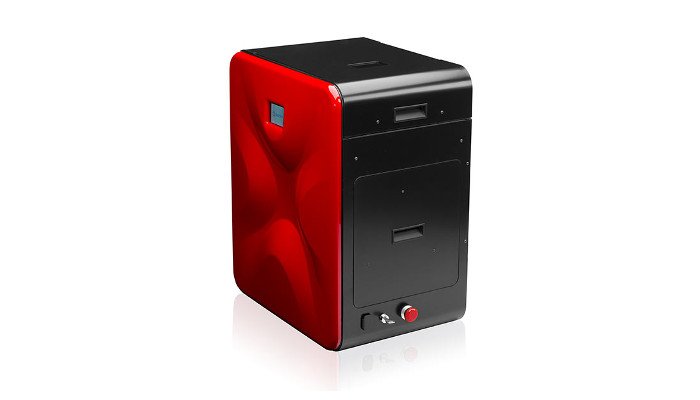
Sintratec Kit — DIY SLS 3D printer
- Cost: €4,999
- Company based: Switzerland
- Print volume: 110 x 110 x 110 mm
Pros
Only DIY SLS 3D printer on sale in the world.
No specialist technical knowledge is required.
Cheapest SLS 3D printer out there.
Cons
Cannot print many parts simultaneously.
Takes 4 days to assemble.
The Sintratec Kit is the only DIY 3D printer kit on this list, and is currently the only DIY SLS 3D printer for sale in the world! Creating an SLS 3D printer kit is a huge achievement considering how much more complex SLS is compared to fused deposition modeling, though the Sintratec takes far longer than a standard kit printer to assemble.
After successfully crowdfunding this SLS 3D printer back in 2014 — raising $213,337, more than their original $175K goal — the Sintratec DIY SLS printer kit has since been released worldwide.
With a modest 110 x 110 x 110 mm print volume, medium-sized parts can be printed without issue. For printing many parts simultaneously however, this may not be the machine for you. The Kit takes around 4 days to assemble, though Sintratec say no specialist technical knowledge is required. You can easily connect to the printer via USB to print, and Sintratec sell their own plastic powders.
If you want to try Selective Laser Sintering and don’t want to break the bank, the Sintratec Kit is also the cheapest SLS 3D printer out there, at just €4,999 — if you don’t mind building it yourself.
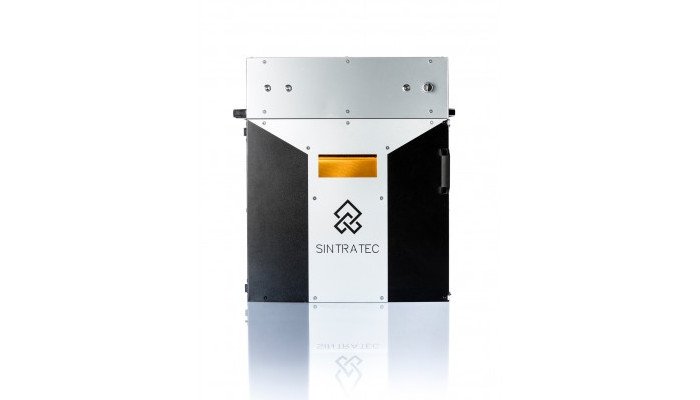
Formlabs Fuse 1
- Price: $9,999
- Company based: USA
- Print volume: 165 x 165 x 320 mm
Pros
Good all-around powder printing solution.
Decent printing volume.
Can be connected via ethernet or WiFi.
Cons
Very heavy at 88kg.
Might be too expensive for some.
American 3D printer company Formlabs have grown astronomically since founding in 2011. Since taking over desktop resin 3D printing with their Form range, the Fuse 1 is Formlabs’ first foray into the SLS 3D printer market. Offering a speed of 10mm/s and a layer thickness of 100µm, the Fuse 1 is a good all-around powder printing solution.
The Fuse 1 can be connected via ethernet or WiFi, and has a very decent printing volume of 165 x 165 x 320 mm. The Fuse 1 is heavy however, weighing in at 88kg, so it’s not exactly easy to move around on a whim. Moreover, the Fuse 1 retails at around $9,999, more expensive than some printers on this list.
*One of our trusted partners will be in touch following a quote request.
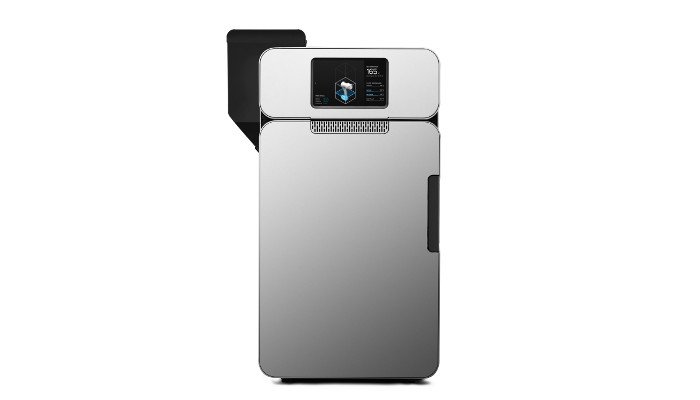
Sinterit Lisa Pro
- Price: $15,000 for the base model — Available on 3DPrima here
- Company based: Poland
- Print volume: 150 x 200 x 260 mm (may be smaller maximum limit for some materials)
Pros
Great precision.
Large build area.
Smooth and accurate powder parts.
Cons
Very expensive.
The Sinterit Lisa Pro is the upgraded version of Sinterit’s original desktop SLS printer, the Lisa. The Lisa Pro comes with a number of improvements, such as better precision: 0.05 mm vs 0.175-0.75 mm. The results are noticeably smoother and more accurate powder parts — very important in industrial applications like prototype testing.
Despite the higher price tag — starting at around $15,000 — many will consider the precision and larger build area worth it. You get their 3D printer software tool with the printer, Sinterit Studio 2019, and though Sinterit sell their own SLS printer powders, the Lisa Pro accepts third party powders.
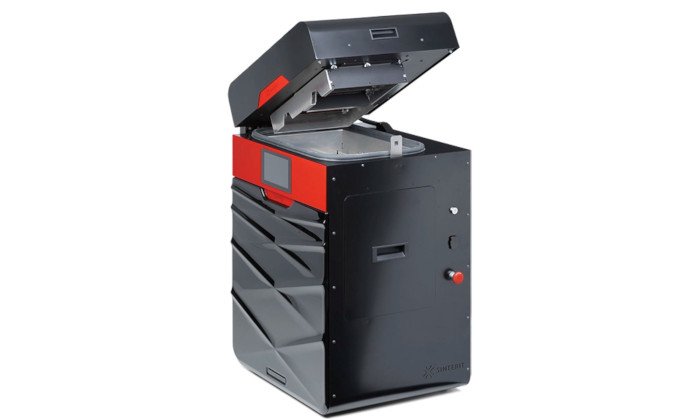
Red Rock 3D
- Company based: Russia
- Price: Unknown
- Print volume: 180 x 180 x 180 mm
Pros
Fairly impressive print volume.
The fast printing speed of 20cm³/h.
Compact, weighing 35kg.
Cons
Can only be used with black Nylon PA12.
Red Rock are the only Russian 3D printer company on our list, having released a compact, desktop SLS 3D printer weighing just 35kg. Their printer, the Red Rock 3D, is an SLS printer developed for rapid prototyping of functional parts.
With a fairly impressive print volume of 180 x 180 x 180 mm, the Red Rock 3D is perfect for batch production. With a printing speed of 20cm³/h, parts can be created fairly quickly to be tested for their effectiveness. The Red Rock powder 3D printer is currently only able to be used with black Nylon PA12, but the Russian company plans to expand their product range in the coming months.
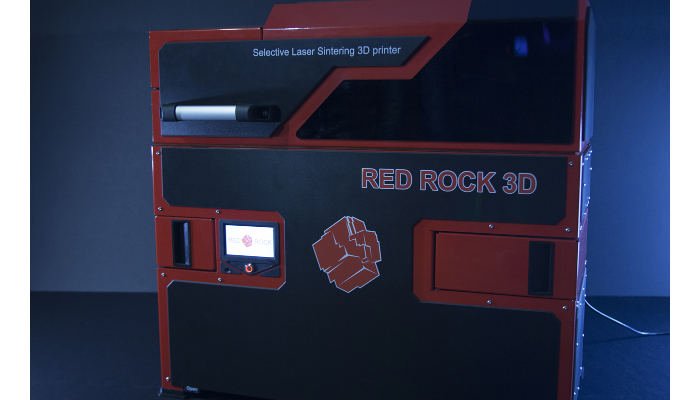
Best Industrial SLS 3D Printer:
Most SLS 3D printers are out of budget for all but the most industrial applications. These industrial machines are used for high-quality pre-manufacturing prototypes, R&D, and uses in sectors such as aerospace, automotives and other sectors.
Sintratec S2
- Price: $30,000 for primary parts; extra for polishing station and other add-ons
- Company based: Switzerland
- Print volume: 160 x 160 x 400 mm
Pros
Scalable compact system.
Fast and accurate.
Great to print parts in a small workshop.
Cons
Not suited for large-scale production.
After the success of both the Sintratec S1 and the Sintratec Kit, the Swiss company have broadened their range with the more industrial Sintratec S2 SLS machine. It calls itself a ‘scalable compact system’ and features a Laser Sintering Station, Material Handling Station, Material Core Unit and other key parts that make this powder 3D printer a one stop shop for SLS printing.
One of the main benefits of the Sintratec S2 is its fantastic height — you can print up to 400 mm tall parts. This opens up new possibilities for taller powder prototypes. It’s also double the speed of the Sintratec Kit, and accurate up to an astonishing 0.3 mm. It’s a huge machine however, so if you are looking to print parts in a small workshop, you need to seriously consider how viable this may be.
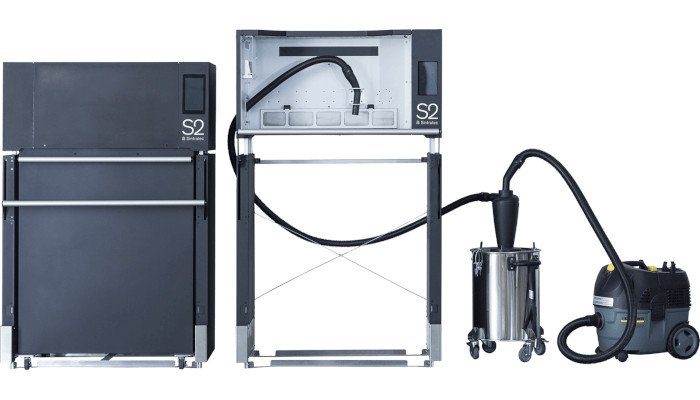
3D Systems ProX SLS 6100
- SLS 3D printer cost: over $100,000
- Company based: USA
- Print volume: 381 x 330 x 460 mm
Pros
Large build volume.
Can print metal powders like aluminum and carbon fiber.
One of the fastest SLS printers in its price range.
Cons
Expensive for an industrial 3D printer.
3D Systems are the original 3D printing firm, having been around since the mid-1980s when they commercialized stereolithography. They’ve since branched out into many other 3D printing technologies, including SLS 3D printers such as their ProX SLS 6100, taking over from the previous SLS 500 model since its release in late 2017.
- For more information on the history of 3D printing, check out our full feature story here.
This industrial SLS 3D printer offers a much larger build volume at 381 x 330 x 460 mm, as well as a layer thickness of between 0.08 and 0.15 mm. It’s fairly speedy, and also versatile, able to print nylon powders filled with other materials, including metal powders like aluminum, or carbon fiber, as well as food-grade materials.
One of the fastest SLS printers in its price range, the ProX SLS 6100 prints up to 2.7 l/h, using 3D Sprint software to maximize efficiency and manufacturing speed. 3D Systems say the ProX 6100 reaches 95% material efficiency due to the Material Quality Control (MQC) system automatically blending and recycling powder, helping lower part costs.
*One of our trusted partners will be in touch following a quote request.
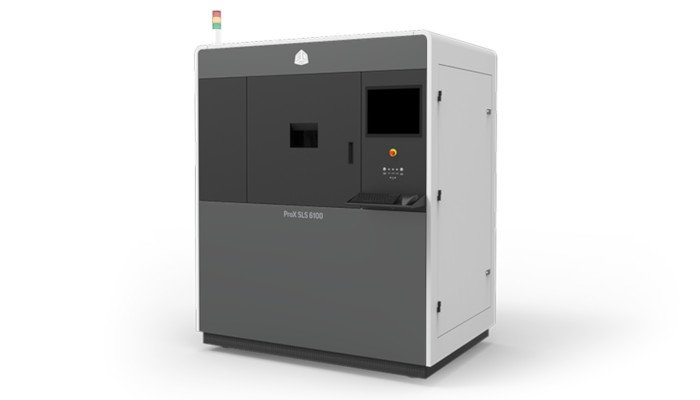
EOS Formiga P 110 Velocis
- 3D printer price: $175,000
- Company based: Germany
- Print volume: 200 x 250 x 300 mm
Pros
Considered the perfect entry-level SLS machine.
No post-processing is needed to remove the marks left by the removed supporting material.
EOS has been in the SLS game since the beginning.
Cons
One of the most expensive SLS printers.
EOS are another major 3D printer manufacturer and a leader in SLS 3D printers, based in Germany. You can trust EOS; they’ve been in the SLS and DMLS 3D printer game since the beginning, and their excellent reputation precedes them.
EOS consider the Formiga P 110 Velocis SLS 3D printer the perfect entry-level SLS machine, with a decent 200 x 250 x 300 mm build volume as well as a varying layer thickness of 0.06/0.1/0.12 mm depending on the materials used.
The German company sell the P 110 Velocis as the simplest SLS printer to use, highlighting the lack of any binding agent or any kind of addition — so your costs are only in the materials, and electricity. The SLS process means no supporting structures are required, and therefore no post processing to remove the marks left by removed supporting material.
Another fairly fast 3D printer, the EOS Formiga P 110 offers a speed of 1.2 l/h, and weighs approximately 600kg.
*One of our trusted partners will be in touch following a quote request.
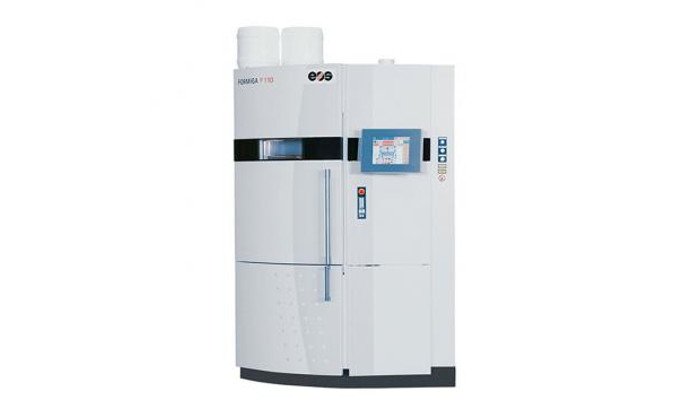
Sharebot SnowWhite 2
- Cost: $40,000 / €35,000
- Company based: Italy
- Print volume: 100 x 100 x 100 mm
Pros
Can print multiple powder options such as Nylon, PA11, TPU, glass, carbon and aluminum.
Designed to be simple to use.
Precis, accurate and large.
Cons
Small print volume.
Sharebot are an Italian 3D printer manufacturer that make FDM 3D printers, metal 3D printers, and have recently followed up the original SnowWhite with their fewest printer, the SnowWhite 2 SLS printer. Bringing their metal 3D printing expertise to selective laser sintering, the SnowWhite 2 is very versatile, able to print a variety of different SLS 3D printer powder options including PA12 (Nylon), PA11, TPU, as well as glass, carbon and aluminum powder mixes.
The printer is designed to be as simple as possible to operate, automating much of the printing setup. It falls in between the desktop and industrial ranges, retaining ease of use — it can be set up in just 10 minutes — while still being precise, accurate and large, with a 50-micron Z-axis resolution, 100-micron XY-resolutions, and weighing 120kg.
- We interviewed Sharebot ahead of the release of their first metal 3D printer, the metalONE. Read it here.
Despite being an industrial printer, the Sharebot SnowWhite 2 has a fairly small print volume. At 100 x 100 x 100 mm, this is not ideal for manufacturing multiple parts simultaneously, and is therefore better served for R&D and rapid prototyping of single parts. The printer costs around $40,000, or €35,000.
*One of our trusted partners will be in touch following a quote request.
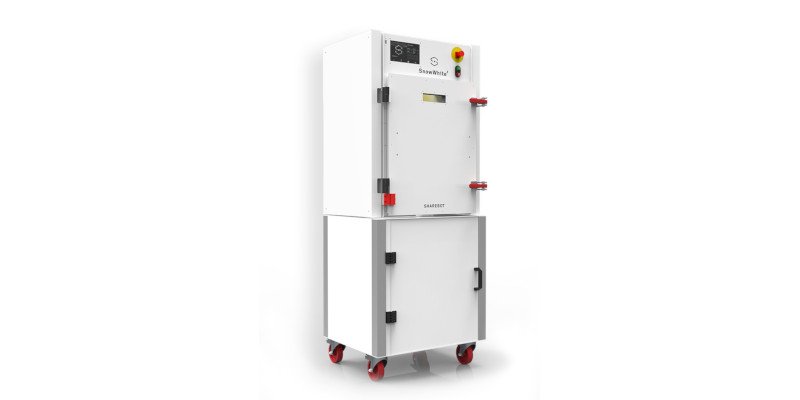
XYZprinting MfgPro230 xS
- Price: $60,000
- Company based: China
- Print volume: 230 x 230 x 230 mm
Pros
Lower price than many competitors.
Great print speed at 1 l/h.
Uses specialized SLS 3D printer software.
Cons
Skilled operator required.
XYZprinting are mostly known for their desktop FDM 3D printers. They have since expanded into other 3D printing technologies, selling an SLA 3D printer and a 3D scanner, as well as their first SLS printer, the MfgPro230 xS. Weighing 360kg, it’s an industrial sized printer, but at a lower price than many competitors.
The MfgPro230 xS prints at 1 l/h speeds, great for small businesses who want to quickly prototype models for engineering and other uses. The printer uses specialized SLS 3D printer software: SLS Build for slicing and optimizing parts for printing, and SLS Ware for remote monitoring and for managing the 3D printing process.
- XYZprinting are best known for low cost FDM printers. Check out our ranking of the best low cost 3D printers.
This professional SLS 3D printer has printing dimensions of 230 x 230 x 230 mm, easily enough to printing multiple functional parts simultaneously. Able to fulfill professional quality demands, with printable layer thicknesses of between 0.08mm and 0.2mm. At $60,000, it offers industrial SLS additive manufacturing at affordable prices.
*One of our trusted partners will be in touch following a quote request.
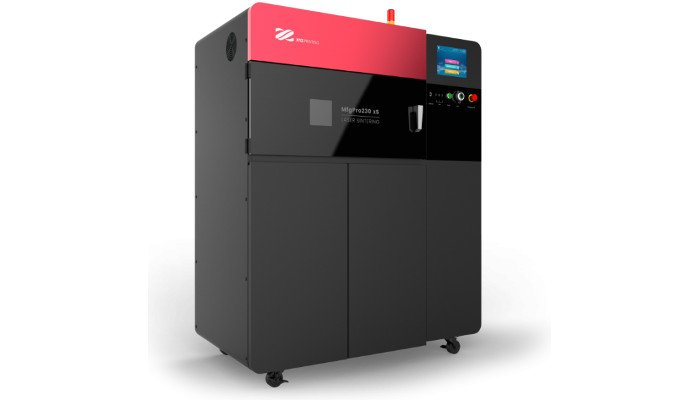
Nexa3D QLS 350 — fastest SLS 3D printer in the world!
- Price: Upon request
- Company based: USA
- Build volume: 350 x 350 x 400 mm
Pros
Prints at 4x the speed of comparable machines.
Claims to be the fastest SLS 3D in the world.
Capable of printing many parts simultaneously.
Cons
Might be too large for some people.
Nexa3D recently purchased NXT Factory, who had pioneered what they term Quantum Laser Sintering (QLS), allowing for much faster SLS 3D printing at 4x the speed of comparable machines. QLS involves splitting the printer’s laser beam into millions of micro-lasers, each sintering parts of the powder at faster speeds.
Incorporating QLS tech into their printer range, the QLS 350 claim’s to be the world’s fastest SLS 3D printer, with print speeds reaching up to 8 l/h! The QLS 350 is compatible with PA11, PA12 and tougher PA6 Nylons, as well as with food-grade, carbon and glass powder mixes.
With speeds that rival injection molding and a build volume capable of printing many parts simultaneously, many businesses will be looking on keenly to see how the QLS 350 performs when it releases — planned to be Q1 2021.
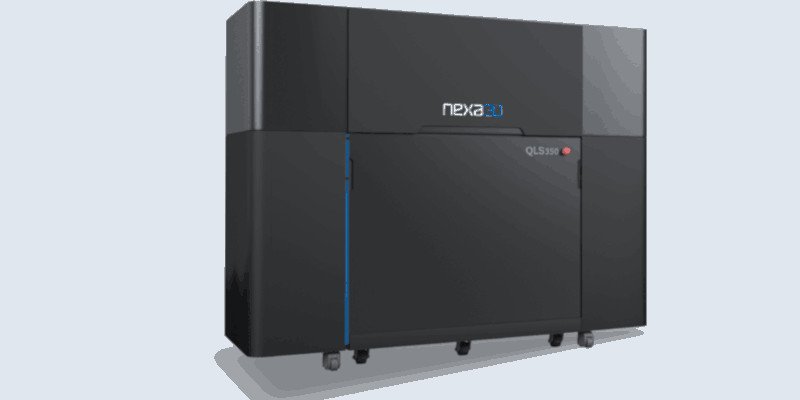
SLS 3D printer applications
As SLS printers can create strong Nylon parts, they are commonly used for:
- Strong, durable parts which need to withstand high heats and exposure to abrasive chemicals such as in the aerospace industry
- Highly impact resistant models
- Medical devices and tools
- Investment casting patterns
- Automotive design protototypes
- Engineering part prototypes
- Seals, gaskets and hoses




